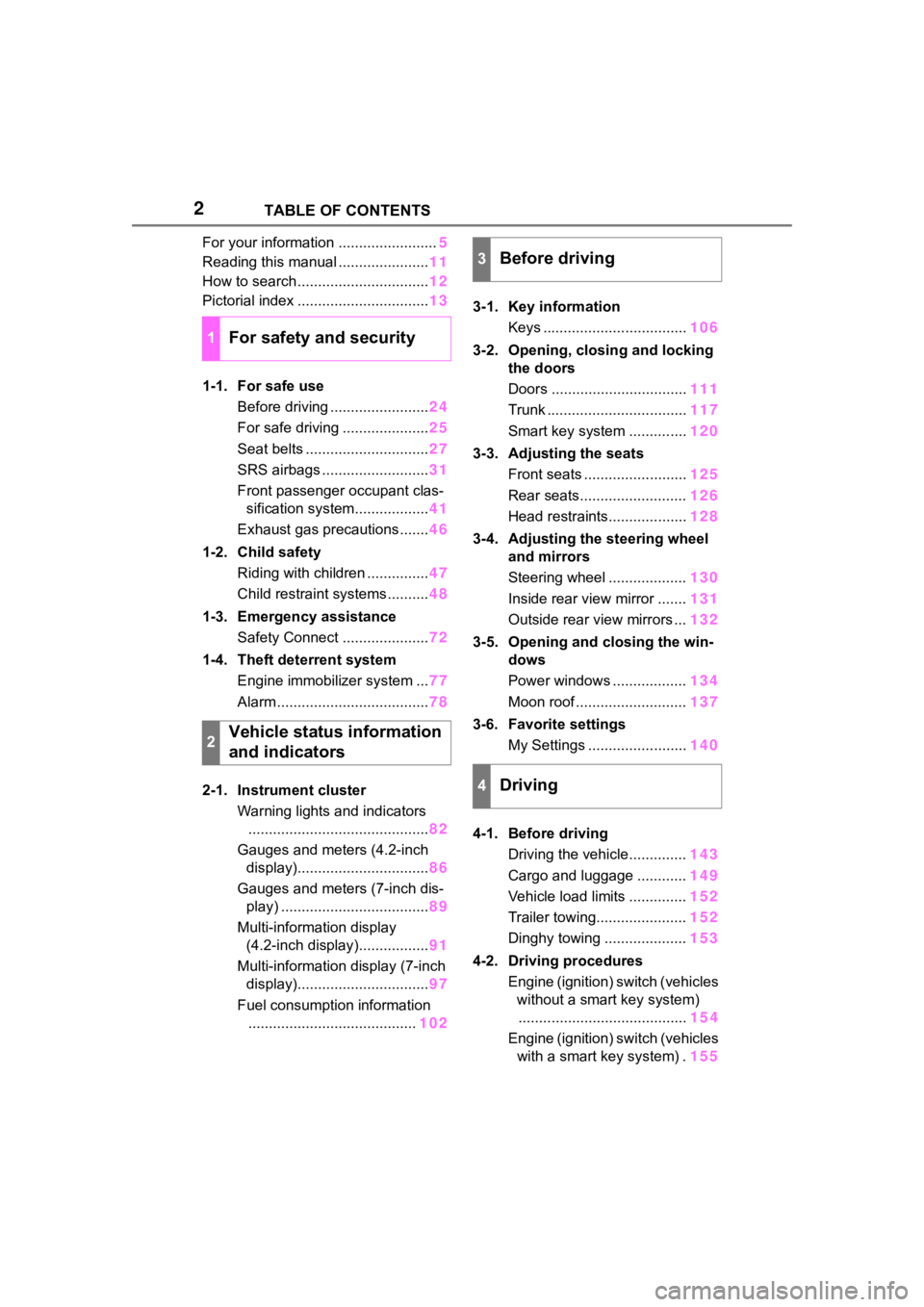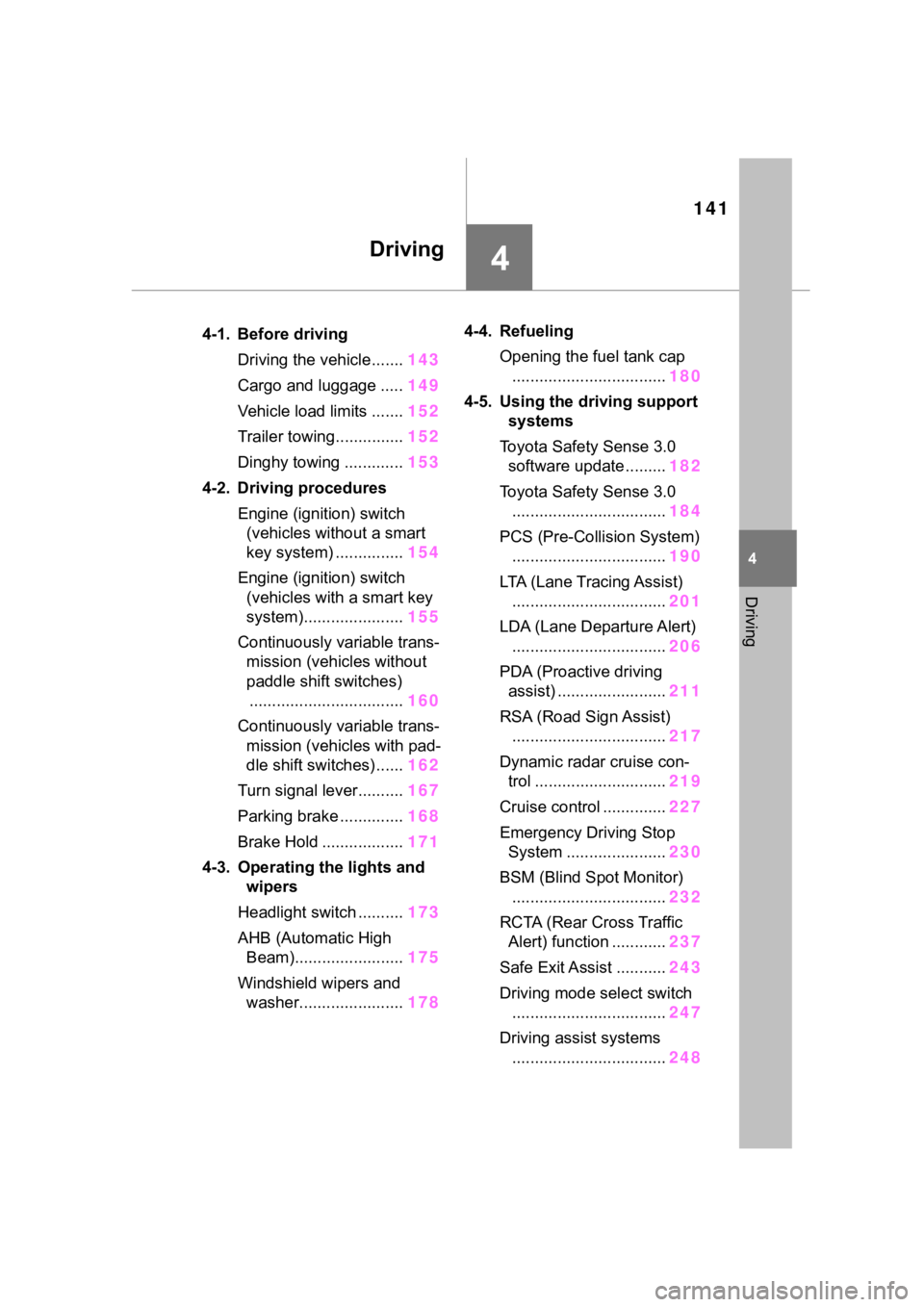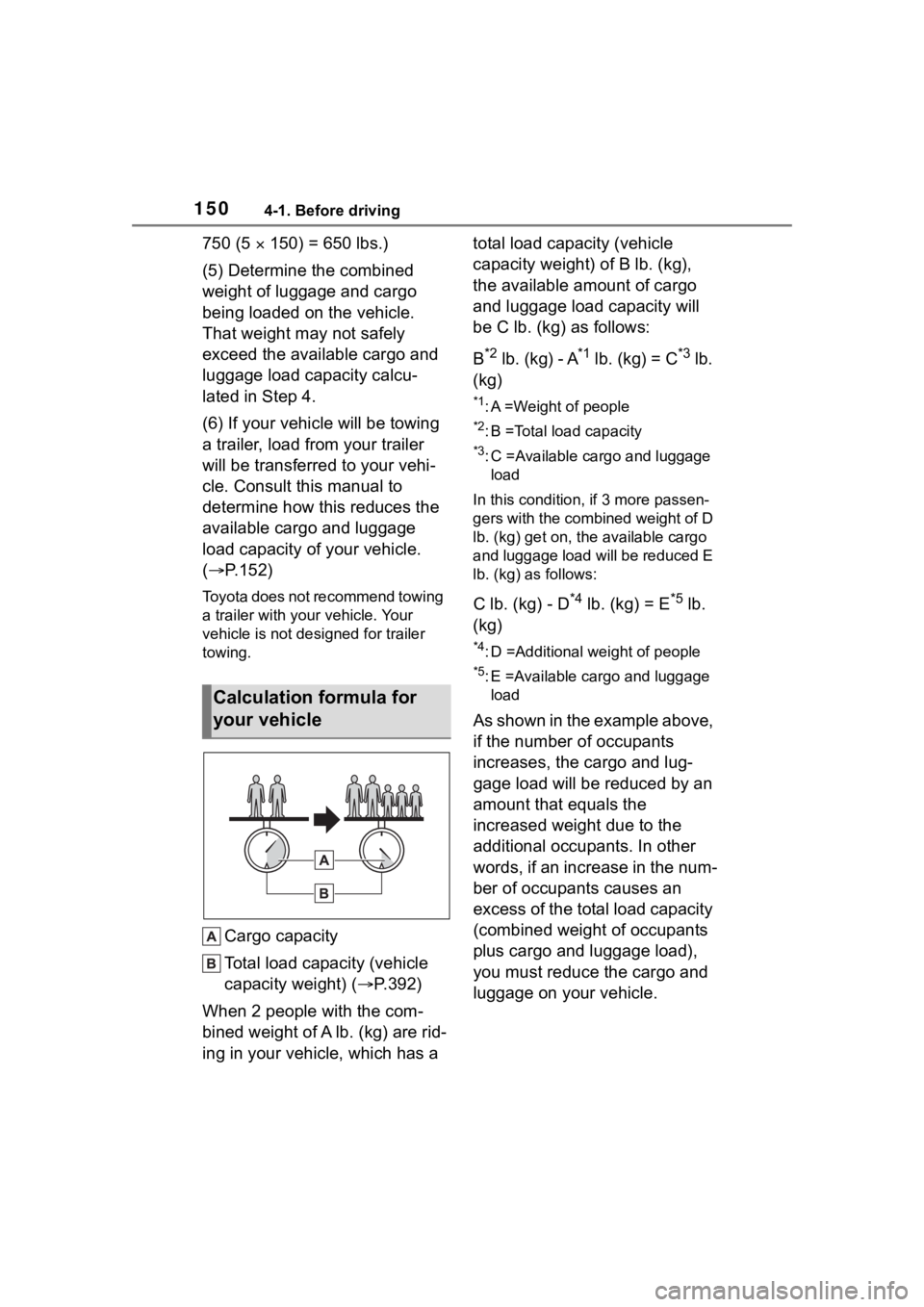2023 TOYOTA COROLLA trailer
[x] Cancel search: trailerPage 2 of 468

2TABLE OF CONTENTS
For your information ........................5
Reading this manual ...................... 11
How to search ................................ 12
Pictorial index ................................ 13
1-1. For safe use Before driving ........................ 24
For safe driving ..................... 25
Seat belts .............................. 27
SRS airbags .......................... 31
Front passenger occupant clas- sification system.................. 41
Exhaust gas precautions....... 46
1-2. Child safety Riding with children ............... 47
Child restraint systems .......... 48
1-3. Emergency assistance Safety Connect ..................... 72
1-4. Theft deterrent system Engine immobilizer system ... 77
Alarm ..................................... 78
2-1. Instrument cluster Warning lights and indicators............................................ 82
Gauges and meters (4.2-inch display)................................ 86
Gauges and meters (7-inch dis- play) .................................... 89
Multi-information display (4.2-inch display)................. 91
Multi-information display (7-inch display)................................ 97
Fuel consumption information ......................................... 1023-1. Key information
Keys ................................... 106
3-2. Opening, closing and locking the doors
Doors ................................. 111
Trunk .................................. 117
Smart key system .............. 120
3-3. Adjusting the seats Front seats ......................... 125
Rear seats.......................... 126
Head restraints................... 128
3-4. Adjusting the steering wheel and mirrors
Steering wheel ................... 130
Inside rear view mirror ....... 131
Outside rear view mirrors ... 132
3-5. Opening and closing the win- dows
Power windows .................. 134
Moon roof ........................... 137
3-6. Favorite settings My Settings ........................ 140
4-1. Before driving Driving the vehicle.............. 143
Cargo and luggage ............ 149
Vehicle load limits .............. 152
Trailer towing...................... 152
Dinghy towing .................... 153
4-2. Driving procedures Engine (ignition) switch (vehicles without a smart key system)........ ................................. 154
Eng
ine (ignition) switch (vehicles
with a smart key system) . 155
1For safety and security
2Vehicle status information
and indicators
3Before driving
4Driving
Page 141 of 468

141
4
4
Driving
Driving
.4-1. Before drivingDriving the vehicle....... 143
Cargo and luggage ..... 149
Vehicle load limits ....... 152
Trailer towing............... 152
Dinghy towing ............. 153
4-2. Driving procedures Engine (ignition) switch (vehicles without a smart
key system) ............... 154
Engine (ignition) switch (vehicles with a smart key
system)...................... 155
Continuously variable trans- mission (vehicles without
paddle shift switches).................................. 160
Continuously variable trans- mission (vehicles with pad-
dle shift switches) ...... 162
Turn signal lever.......... 167
Parking brake .............. 168
Brake Hold .................. 171
4-3. Operating the lights and wipers
Headlight switch .......... 173
AHB (Automatic High Beam)........................ 175
Windshield wipers and washer....................... 1784-4. Refueling
Opening the fuel tank cap.................................. 180
4-5. Using the dr iving support
systems
Toyota Safety Sense 3.0 software update ......... 182
Toyota Safety Sense 3.0 .................................. 184
PCS (Pre-Collision System) .................................. 190
LTA (Lane Tracing Assist) .................................. 201
LDA (Lane Departure Alert) .................................. 206
PDA (Proactive driving assist) ........................ 211
RSA (Road Sign Assist) .................................. 217
Dynamic radar cruise con- trol ............................. 219
Cruise control .............. 227
Emergency Driving Stop System ...................... 230
BSM (Blind Spot Monitor) .................................. 232
RCTA (Rear Cross Traffic Alert) function ............ 237
Safe Exit Assist ........... 243
Driving mode select switch .................................. 247
Driving assist systems .................................. 248
Page 150 of 468

1504-1. Before driving
750 (5 150) = 650 lbs.)
(5) Determine the combined
weight of luggage and cargo
being loaded on the vehicle.
That weight may not safely
exceed the available cargo and
luggage load capacity calcu-
lated in Step 4.
(6) If your vehicle will be towing
a trailer, load from your trailer
will be transferred to your vehi-
cle. Consult this manual to
determine how this reduces the
available cargo and luggage
load capacity of your vehicle.
( P.152)
Toyota does not recommend towing
a trailer with your vehicle. Your
vehicle is not designed for trailer
towing.
Cargo capacity
Total load capacity (vehicle
capacity weight) ( P.392)
When 2 people with the com-
bined weight of A lb. (kg) are rid-
ing in your vehicle, which has a total load capacity (vehicle
capacity weight) of B lb. (kg),
the available amount of cargo
and luggage load capacity will
be C lb. (kg) as follows:
B
*2 lb. (kg) - A*1 lb. (kg) = C*3 lb.
(kg)
*1: A =Weight of people
*2: B =Total load capacity
*3: C =Available cargo and luggage load
In this condition, if 3 more passen-
gers with the combined weight of D
lb. (kg) get on, the available cargo
and luggage load will be reduced E
lb. (kg) as follows:
C lb. (kg) - D*4 lb. (kg) = E*5 lb.
(kg)
*4: D =Additional weight of people
*5: E =Available cargo and luggage load
As shown in the example above,
if the number of occupants
increases, the cargo and lug-
gage load will be reduced by an
amount that equals the
increased weight due to the
additional occupants. In other
words, if an increase in the num-
ber of occupants causes an
excess of the total load capacity
(combined weight of occupants
plus cargo and luggage load),
you must reduce the cargo and
luggage on your vehicle.
Calculation formula for
your vehicle
Page 152 of 468

1524-1. Before driving
■Total load capacity and seating
capacity
These details are also described on
the tire and loading information
label. ( P.328)
Vehicle load limits
Vehicle load limits include
total load capacity, seating
capacity, towing capacity
and cargo capacity.
Total load capacity (vehicle
capacity weight): P.392
Total load capacity means the
combined weight of occupants,
cargo and luggage.
Seating capacity: P.392
Seating capacity means the max-
imum number of occupants
whose estimated average weight
is 150 lb. (68 kg) per person.
Towing capacity
Toyota does not recommend tow-
ing a trailer with your vehicle.
Cargo capacity
Cargo capacity may increase or
decrease depending on the
weight and the number of occu-
pants.
WARNING
■Overloading the vehicle
Do not overload the vehicle.
It may not only cause damage to
the tires, but also degrade steer-
ing and braking ability, resulting in
an accident.
Trailer towing
Toyota does not recom-
mend towing a trailer with
your vehicle. Toyota also
does not recommend the
installation of a tow hitch or
the use of a tow hitch carrier
for a wheelchair, scooter,
bicycle, etc. Your vehicle is
not designed for trailer tow-
ing or for the use of tow
hitch mounted carriers.
Page 188 of 468

1884-5. Using the driving support systems
■Situations in which the sensors
may not operate properly
●When the height or inclination of
the vehicle has been changed due
to modifications
●When the windshield is dirty,
fogged up, cracked or damaged
●When the ambient temperature is
high or low
●When mud, water, snow, dead
insects, foreign matter, etc., is
attached to the front of the sensor
●When in inclement weather such
as heavy rain, fog, snow, or a
sandstorm
●When water, snow, dust, etc. is
thrown up in front of the vehicle, or
when driving through mist or
smoke
●When the headlig hts are not illu-
minated while driving in the dark,
such as at night o r when in a tun-
nel
●When the lens of a headlight is
dirty and illumination is weak
●When the headlights are mis-
aligned
●When a headlight is malfunction-
ing
●When the headlights of another
vehicle, sunlight, or reflected light
shines directly into the front cam-
era
●When the brightness of the sur-
rounding area changes suddenly
●When driving near a TV tower,
broadcasting station, electric
power plant, radar equipped vehi-
cles, etc., or other location where
strong radio waves or electrical
noise may be present
●When a wiper blade is blocking
the front camera
●When in a location or near objects
which strongly reflect radio waves,
such as the following:
• Tunnels
• Truss bridges
• Gravel roads
• Rutted, snow-covered roads
• Walls
• Large trucks
• Manhole covers
• Guardrail
• Metal plates
●When near a step or protrusion
●When a detectable vehicle is nar-
row, such as a small mobility vehi-
cle
●When a detectable vehicle has a
small front or rear end, such as an
unloaded truck
●When a detectable vehicle has a
low front or rear end, such as a
low bed trailer
●When a detectable vehicle has
extremely high ground clearance
WARNING
■Front camera installation area
on the windshield
If the system determines that the
windshield may be fogged up, it
will automatically operate the
heater to defog the part of the
windshield around the front cam-
era. When cleaning, etc., be care-
ful not to touch the area around
the front camera until the wind-
shield has cooled sufficiently, as
touching it may cause burns.
Page 241 of 468

2414-5. Using the driving support systems
4
Driving
etc.), bicycle carrier, or snow plow
●When backing up on a slope with
a sharp change in grade
●When backing out of a sharp
angle parking spot
●Immediately after the RCTA func-
tion is turned on
●Immediately afte r the engine is
started with the RCTA function on
●When the sensors cannot detect a
vehicle due to obstructions
●When towing a trailer
●When there is a significant differ-
ence in height between your vehi-
cle and the vehicle that enters the
detection area
●When a sensor or the area around
a sensor is extremely hot or cold
●If the suspension has been modi-
fied or tires of a size other than
specified are installed
●If the front of the vehicle is raised
or lowered due to the carried load
●When turning while backing up
●When a vehicle tu rns into the
detection area
■Situations in which the system
may operate even if there is no
possibility of a collision
Instances of the RCTA function
unnecessary detec ting a vehicle
and/or object may increase in the
following situations:
●When the parking space faces a
street and vehicles are being
driven on the street
●When the distance between your
vehicle and metal objects, such as
a guardrail, wall, sign, or parked
vehicle, which may reflect electri-
cal waves toward the rear of the
vehicle, is short
Page 448 of 468

448Alphabetical Index
Tail lightsLight switch .......................... 173
Replacing light bulbs ............ 341
Theft deterrent system Alarm ...................................... 78
Engine immobilizer system .... 77
Tire inflation pre ssure............ 328
Maintenance data................. 397
Warning light ........................ 360
Tire information ...................... 401 Glossary ............................... 405
Size ...................................... 403
Tire identification number ..... 403
Uniform Tire Quality Grading 404
Tire pressure warning system Function ............................... 313
Installing tire pressure warning valves and transmitters ...... 315
Registering ID codes ............ 322
Registration of the position of each wheel ......................... 316
Setting the tire pressure ....... 318
Warning light ........................ 360
Tires Chains .................................. 254
Checking .............................. 311
If you have a flat tire ............. 370
Inflation pressure.................. 328
Information ........................... 401
Replacing ............................. 370
Rotating tires ........................ 313
Size ...................................... 397
Snow tires ............................ 253
Spare tire.............................. 370
Tire pressure warning system........................................... 313
Warning light ........................ 360
Tools ........................................ 371
Top tether strap ........................ 68
Total load capacity ................. 392
To w i n g Dinghy towing....................... 153 Emergency towing ................351
Towing eyelet........................353
Trailer towing ......
..................152
Toyota Safety Sense AHB (Automatic High Beam) 175
Cruise control .......................227
Dynamic radar cruise control 219
Emergency Driving Stop System...........................................230
LDA (Lane Departure Alert) ..206
LTA (Lane Tracing Assist) .....201
PCS (Pre-Collisio n System) .190
RSA (Road Sign Assist) ........217
Toyota Safety Sense 3.0[Toyota Safety Sense 3.0]PDA (Proactive driving assist) [PDA (Proactive driving assist)]........................................... 211
TRAC (Traction Control) ........249
Traction Control (TRAC) ........249
Trailer towing ..........................152
Transmission Continuously variable transmis-sion .............................160, 162
Driving mode select switch ...247
If th e s hif t le ver ca n no t b e s hif te d from P .........................161, 164
M mode ................................165
Paddle shift switches ....164, 165
Trip meters ..........................87, 90
Trunk ........................................ 117 Internal trunk rele ase lever ... 119
Smart key system ................. 118
Trunk light ............................. 119
Trunk opener ........................ 118
Wireless remote control........ 118
Trunk light ............................... 119 Wattage ................................398
Turn signal lights Replacing light bulbs ............341
Turn signal lever ...................167
Wattage ................................398